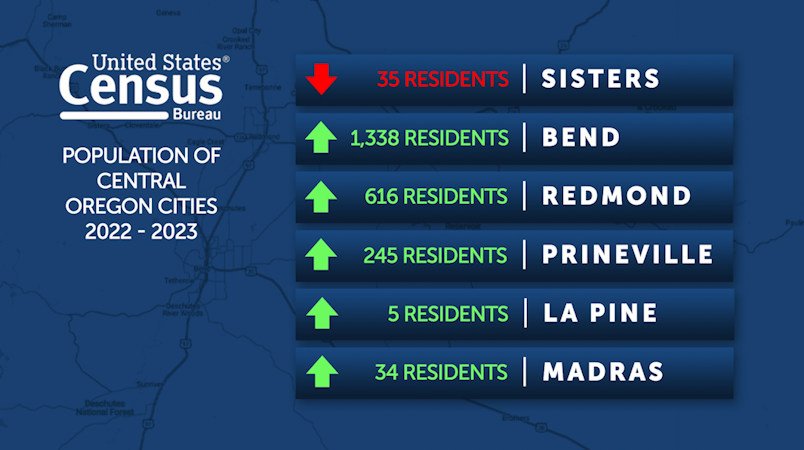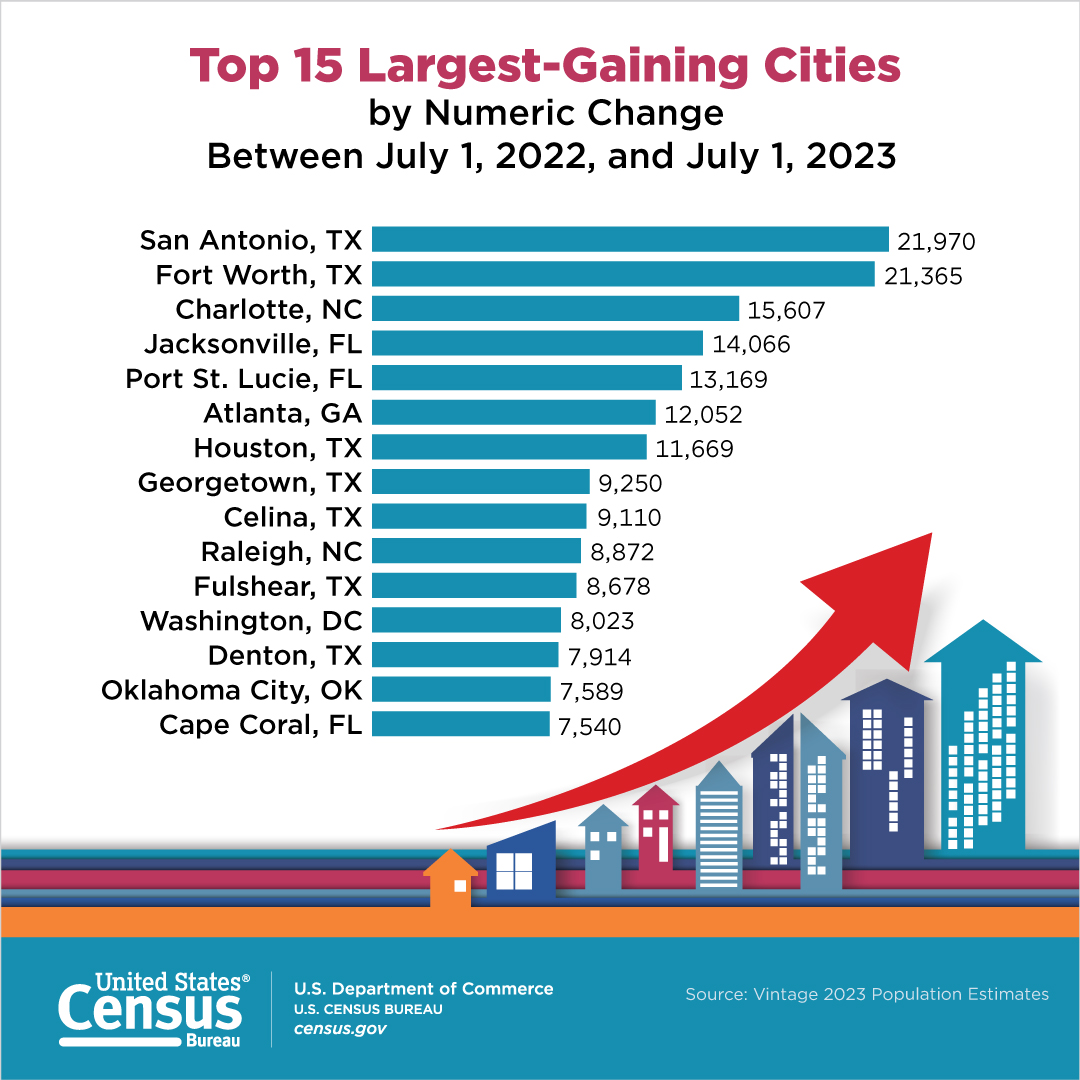All but one of Central Oregon’s cities – Sisters – were still growing last year, according to new Census Bureau estimates

But Portland State's estimates differ - and they say Sisters has 844 more people
BEND, Ore. (KTVZ) – It’s been a long time since Bend and Deschutes County often led not just the state but were among the fastest-growing spots in the country. But while some parts of the U.S. and Oregon, led by Portland, are actually seeing population declines, new Census Bureau estimates out Thursday show that’s not true here.
For the most part.
Sort of.
Why sort of? Because the Census Bureau isn’t the only population estimate game in town, or our state.
Portland State University’s Population Research Center also estimates each city’s and county’s population, for the same date – July 1st of each year.
The Census Bureau and PSU use different sets of national and state data to reach their estimates, so they can vary a lot, especially true the farther we get from the once-a-decade head count.
Perhaps the best example for July 1, 2023 estimates is the still-small town of Sisters, which according to the Census Bureau lost 35 residents in the past year, falling back below 3,000, to 2,979 as of last July.
But PSU begs to differ. It’s estimate for the Sisters population last year was 3,823 residents – that’s 844 more than the feds' estimate.
City of Bend Senior Planner Damian Syrnyk -- a former Deschutes County planner, and before that a PSU population researcher -- notes that they rely on state-level data, such as births, deaths, DMV license changes and income taxes, along with housing data.
The Census Bureau says it uses data on births, deaths and domestic and international migration, producing county-level estimates and then using housing estimates to distribute the numbers to the cities.
Both 2023 estimates show Bend growing, with a Census Bureau estimate of 104,557 residents, up 1,338, or about 1.3% from the previous year. But PSU’s estimate says Bend reached a size of 106,275, or more than 1,700 more people.
Redmond, according to the Census Bureau, grew by 616, to 37,009 residents, while PSU estimated a population of 38,208, or about 1,200 higher.
Prineville’s Census Bureau estimate was 11,754 residents, up 245, or 2.1% from 2022. In this case, PSU actually had a bit lower estimate for Prineville of 11,598, which is 147 fewer than the federal figures.
Smaller cities can see smaller variations (but not always). Culver, the Census Bureau says, added 10 people, for a total of 1,670, and that’s four more folks than the PSU estimates.
La Pine also barely grew, the Census Bureau says, up just five people in a year, to 2,540 residents. But in this case, the variation to the Portland State estimate is striking – they estimated 3,126 La Pine residents last July, nearly 600 more than the Census folks for the same point in time.
Madras, meanwhile, grew by 34 residents, to 7,744 people last July, according to the new Census Bureau estimates. PSU estimated 355 more Madras residents, totaling nearly 8,100.
But Portland’s estimate fell for the third straight year, to 630,498, about 23,000 fewer than counted in 2020. PSU’s estimate for Oregon’s largest city is larger, at 648,097.
Here’s some national perspective, from the Census Bureau.
Population Rebounds for Many Cities in Northeast and Midwest
South Continues to Lead the Way With Largest and Fastest Growth
MAY 16, 2024 — Large cities in the Northeast and Midwest grew in 2023, reversing earlier population declines, according to Vintage 2023 Population Estimates released today by the U.S. Census Bureau.
Cities with populations of 50,000 or more grew by an average of 0.2% in the Northeast and 0.1% in the Midwest after declining an average of 0.3% and 0.2%, respectively, in 2022. Those in the West went up by an average of 0.2% from 2022 to 2023. Cities in the South grew the fastest – by an average 1.0%.
“The population growth across the South in 2023 was driven by significant numeric and percentage gains among its cities,” said Crystal Delbé, a statistician in the Census Bureau’s Population Division. “Thirteen of the 15 fastest-growing cities were in the South, with eight in Texas alone.”
Topping the list of fastest-growing cities with a population of 20,000 or more: Celina, Texas, (near Dallas), whose population grew by 26.6%, more than 53 times that of the nation’s growth rate of 0.5%.
Meanwhile, San Antonio, Texas, added more people (roughly 22,000) than any other city in 2023, reclaiming its No. 1 spot on the list of gainers and pushing it close to the 1.5 million population milestone.
Amid these notable examples of growth in the South, other fast-growing cities saw their rates of population change slow. For example, population growth in Georgetown, Texas, slowed by more than one-fourth its population growth in 2022, from 14.4% to 10.6%. The same can be said for Kyle, Texas, whose population growth decreased by nearly 2.0% to 9.0% in 2023.


Population Change in Small Towns and Regional Differences
While 39% of the country’s population lived in cities of 50,000 or more, the United States remained a nation of mostly smaller communities. Of approximately 19,500 incorporated places, about 75% had fewer than 5,000 people in 2023 and nearly 33% had fewer than 500.
On average, these small towns experienced uneven population change across the U.S. regions. In particular, small towns in the Midwest and Northeast experienced lower rates of decline in 2023, decreasing by an average of 0.3% and 0.1%, respectively, compared to 0.4% and 0.2%, respectively, in 2022.
Meanwhile, small towns in the West grew on average by 0.3% in 2023, a slower pace than its 0.5% growth rate in 2022. In contrast, small towns in the South grew by an average 0.6% in 2023, one-and-a-half times faster than the 0.4% growth in 2022.
Most Populous Cities
The 15 largest cities in 2023 remained the same as in 2022, with a few rank changes – Jacksonville, Florida, surpassed Austin, Texas, while Fort Worth, Texas, surpassed San Jose, California.
New York, New York, remained the nation’s largest city as of July 1, 2023, with almost 8.3 million people, followed by Los Angeles, California, which reached nearly 4 million people.
Other most populous cities in 2023 were:
- Chicago, Illinois (2.7 million).
- Houston, Texas (2.3 million).
- Phoenix, Arizona (1.7 million).
- Philadelphia, Pennsylvania (1.6 million).
- San Antonio (1.5 million).
- San Diego, California (1.4 million).
- Dallas (1.3 million).
- Jacksonville, Florida (986,000).
- Austin (980,000).
- Fort Worth, Texas (978,000).
- San Jose (970,000).
- Columbus, Ohio (913,000).
- Charlotte, North Carolina (911,000).
Discover population changes in large cities and minor civil divisions with “How Is Population Shifting in Your State?”.
Other Highlights
Crossing population milestones:
- Four cities crossed the 100,000-population mark in 2023:
- Yuma, Arizona (100,858).
- Fayetteville, Arkansas (101,680).
- Palm Coast, Florida (102,113).
- Suffolk, Virginia (100,659).
- Five places joined the list of cities with populations of 50,000 or more in 2023:
- Prescott Valley, Arizona (50,045).
- Everett, Massachusetts (50,318).
- Gallatin, Tennessee (50,355).
- Saratoga Springs, Utah (52,532).
- Bothell, Washington (50,213).
- Twenty-one places in 11 states crossed the 20,000-population threshold in 2023.
Modest Housing Unit Growth in Nearly All States
The nation’s housing stock grew by about 1.6 million units between July 1, 2022, and July 1, 2023, reaching a total of 145.3 million. The 1.1% increase was nearly the same as the 1.2% increase between 2021 and 2022.
- California had the largest number of housing units (14.8 million), followed by Texas (12.4 million) and Florida (10.5 million), while Wyoming (280,000) and Alaska (330,000) had the fewest housing units.
- Utah experienced the nation’s fastest growth in housing units, with an increase of 2.5% between July 1, 2022, and July 1, 2023, followed by Idaho (2.3%) and South Dakota (2.2%).
- Alaska (0.1%), Rhode Island (0.2%) and Illinois (0.2%) had the slowest rates of housing growth.
- The largest numeric gains in housing units between July 1, 2022, and July 1, 2023:
- Harris County, Texas (36,000).
- Maricopa County, Arizona (36,000).
- Los Angeles County, California (29,000).
- Travis County, Texas (24,000).
- Collin County, Texas (18,000).
- Falls Church, Virginia, was the fastest-growing county; its housing stock increased by 13.5% between July 1, 2022, and July 1, 2023, followed by Rich County, Utah (8.5%), and Jasper County, South Carolina (7.1%). Wasatch County, Utah, and Billings County, North Dakota, were tied for fourth place with 6.1%.
- Sharkey County, Mississippi, had the largest percentage decrease in housing units between 2022 and 2023 at 10.0%, followed by Breathitt County, Kentucky, at 1.9% and Cross County, Arkansas, with 1.4%.
The complete list of counties is available in "A Snapshot of the Nation’s Housing Stock".
